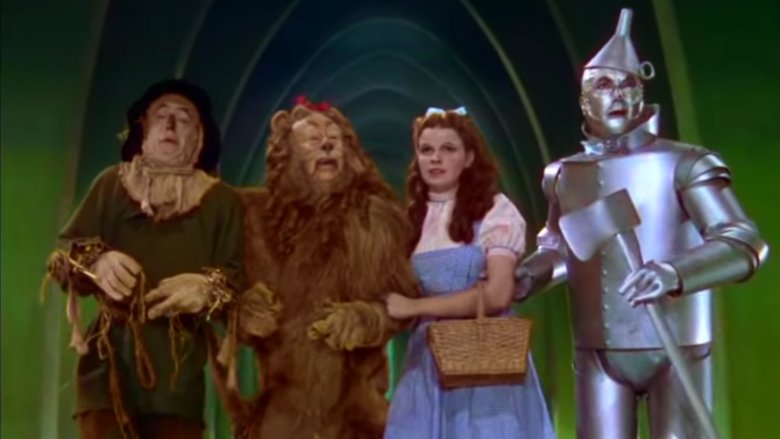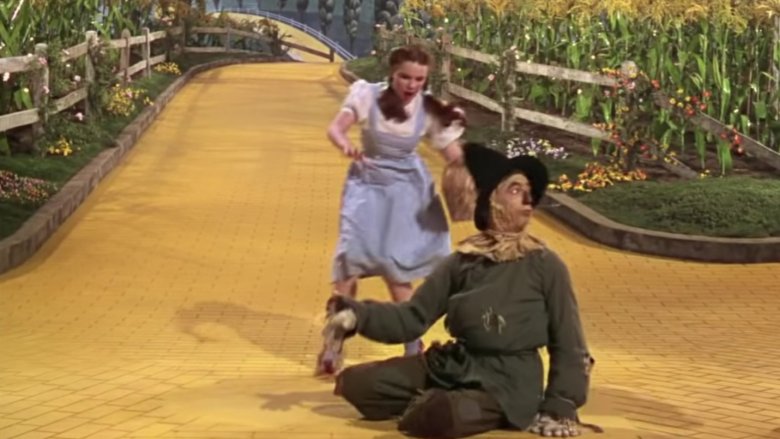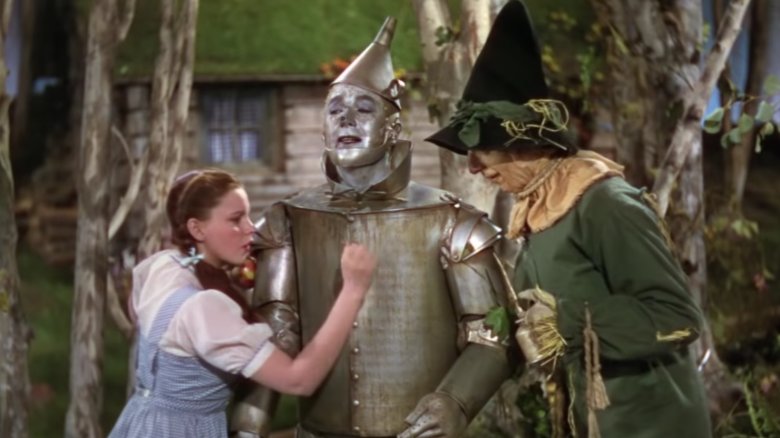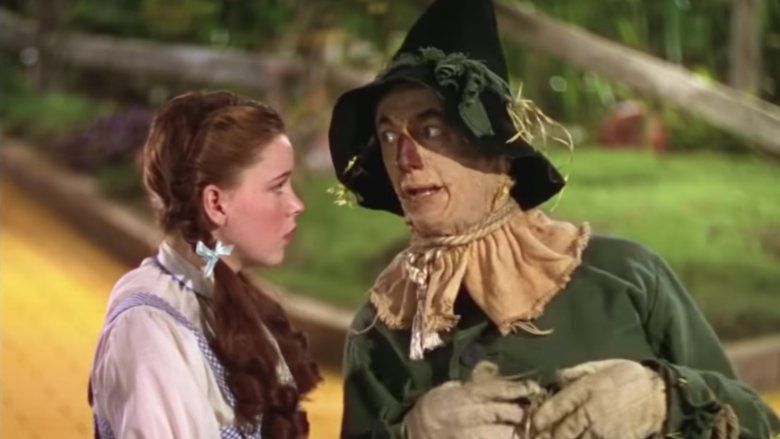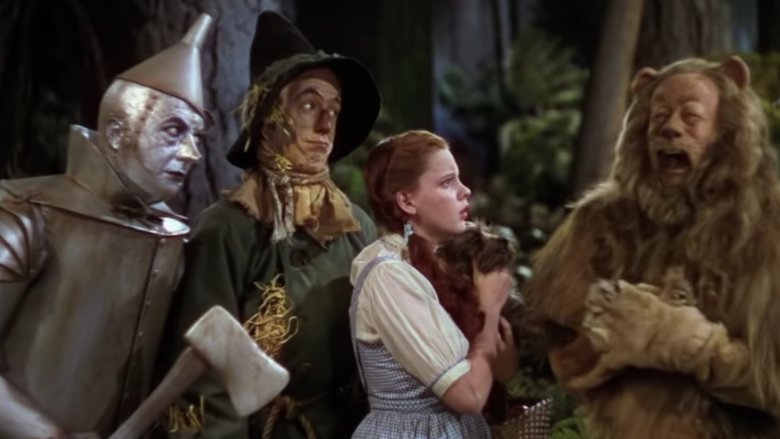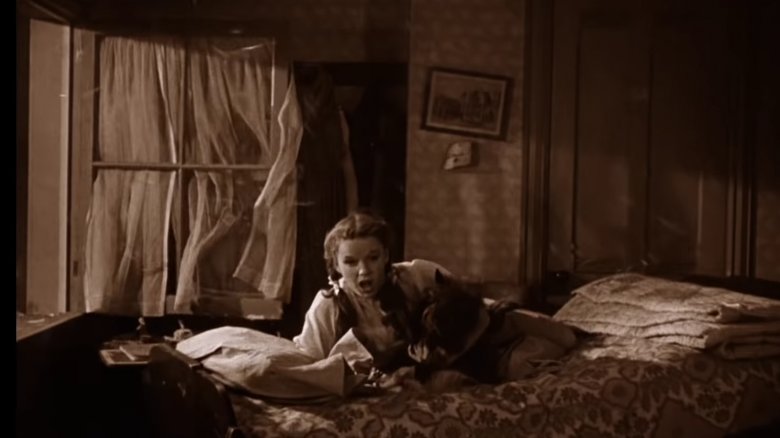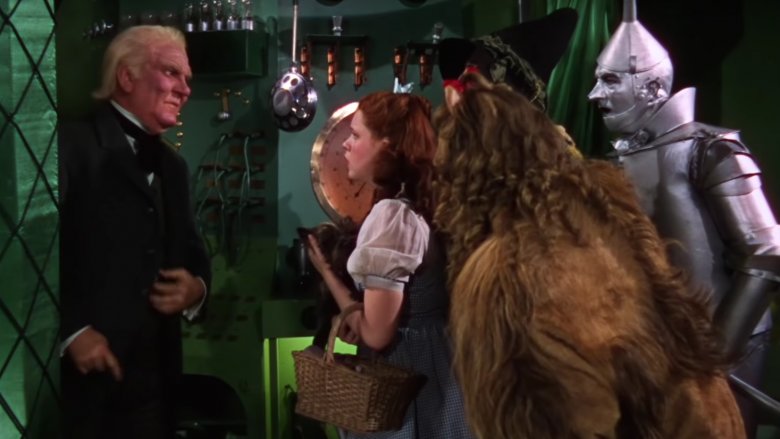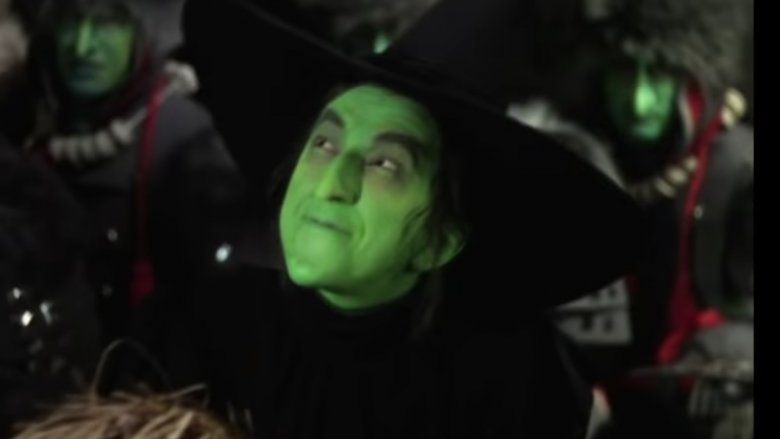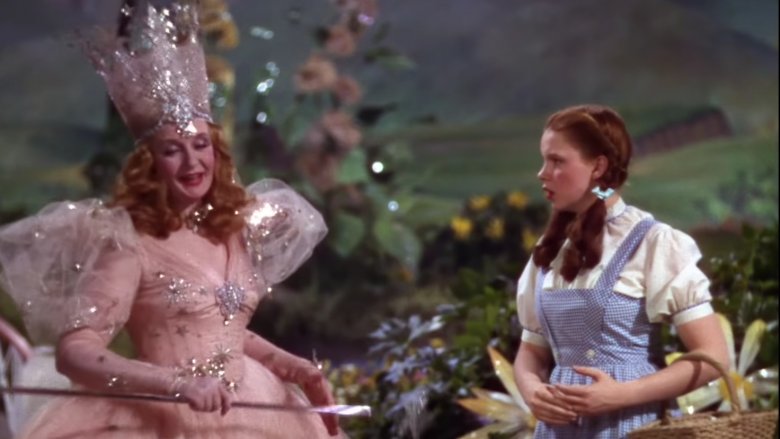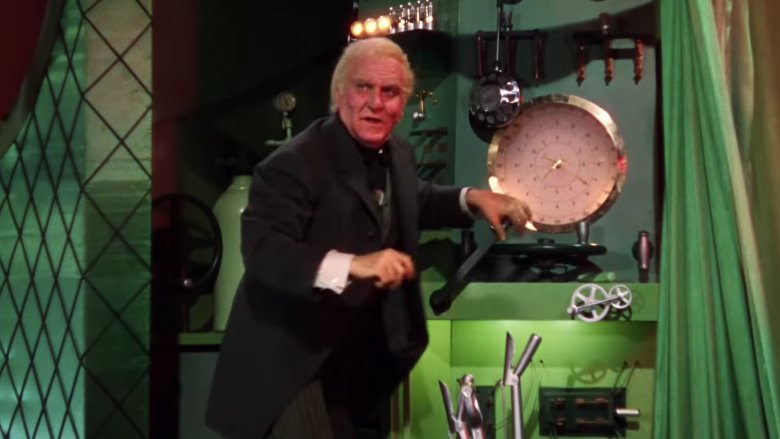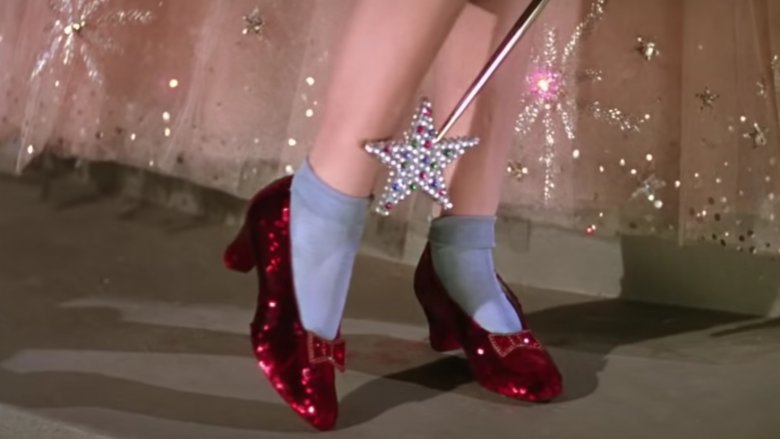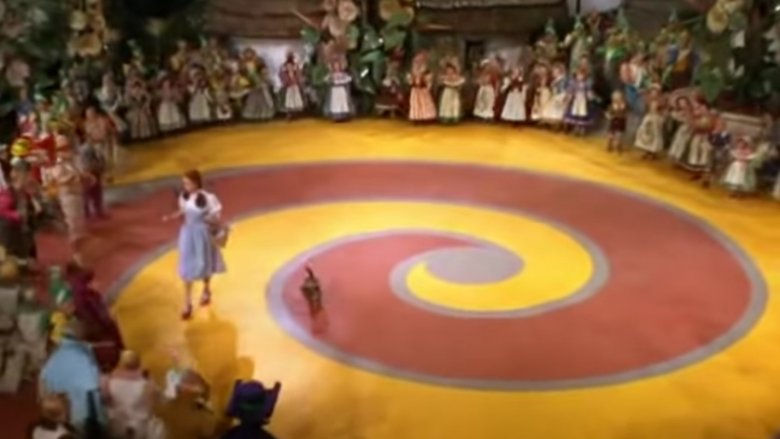The Real Meaning Of These Wizard Of Oz Characters
L. Frank Baum wrote 14 Wizard of Oz books, but his biggest home run was 1900's The Wonderful Wizard of Oz, which MGM turned into a wonderful Wizard of Oz movie. Both versions tell the story of Dorothy Gale and her adorable dog Toto getting stranded in a fantastical land by a tornado, and both include the iconic characters of the Scarecrow, Cowardly Lion, Tin Man, Glinda the Good Witch, and the wizard of fraud, Oz. But unlike the movie, the book features creatures like a giant lion-eating spider and tiny people made of china. Moreover, Dorothy's shoes aren't ruby, and the journey isn't a dream despite nightmarish sequences.
Scholars and avid fans have long pondered what this acid-like trip down the yellow brick road means. So let's explore different interpretations of the story and its characters, primarily addressing the book and film separately for clarity's sake, and also discuss which interpretations seem most plausible. With or without Judy Garland's amazing singing, Baum's bizarre fairy tale will make you feel like you're way up high over the rainbow beyond the dark side of the moon. So prepare for a crazy journey.
You can't judge the book by its intro
If you take Frank Baum's intro to The Wonderful Wizard of Oz at face value, then searching for symbolism is just like the journey to see Oz: a misguided quest to find something that doesn't exist in order to obtain what you already had. Just as Oz wasn't a wizard and Dorothy possessed the power to return home (her magic shoes) from the start, the intro tells you that you don't need to look for the book's hidden meaning because "the story ... was written solely to pleasure children of today." Baum's grandson, Roger, supported this interpretation, per the Chicago Tribune.
However, if you read the introduction in context, you might find that just like the titular wizard, the book is secretly the opposite of what Baum initially describes. For instance, the author also says the story eliminates the elements of "old-time" fairy tales such as genies, dwarfs, and "horrible and blood-curdling incident[s]." But the Munchkins are more or less dwarfs, the flying monkeys are essentially genies (they're controlled by a golden cap instead of a golden lamp and even grant three wishes), and gruesome incidents abound. There are multiple decapitations, and the Tin Man started off as a human who was gradually chopped to pieces by an enchanted ax. So when Baum says there's no moral to the story, there's probably more to the story.
Art imitates Baum's life
Various characters and themes in The Wizard of Oz seem to be ripped straight from the pages of Frank Baum's life. Author Evan Schwartz writes that Baum named Dorothy Gale after his niece, Dorothy Gage, who passed away at 5-months-old. Baum wanted to "[honor] the child's unrealized potential," so it's only appropriate that throughout the story Dorothy Gale doesn't realize the power she possesses the whole time. Glinda the Good Witch seems like an obvious nod to Baum's mother-in-law, Matilda Gage, a prominent feminist who argued that the idea of witches was historically used to demonize women.
Perhaps the most autobiographical character is the Tin Man. The Chicago Tribune notes that Baum had a bad heart, which is echoed in the Tin Man's missing ticker. Moreover, Baum had a heart attack before marrying Maud Gage, and the Tin Man — who was once human — loses his heart in a magic ax attack that prevents him from marrying a Munchkin. Even the plot line of Dorothy being stranded in a strange land with a yellow brick road might be based on a chapter from Baum's life. Patch reports that as a child he attended military school away from home. He traveled via steamship, and a literal yellow brick road called West Street "led from the dock onto Water Street." He had a miserable time and begged to come home.
'The Wizard of Oz' as a Populist allegory
Prior to 1964, people largely regarded The Wizard of Oz as little more than an entertaining fairy tale, according to the National Museum of American History. That changed, thanks to an essay by historian and high school teacher Henry Littlefield, who argued that the story doubles as an allegory for America's 1890s Populist movement. To be clear, Littlefield invented this subtext as a teaching tool, per Smithsonian. Tying Populism to The Wizard of Oz was a useful way to hold students' attention, but there's "no evidence" that Baum embraced the political movement. Nevertheless, many people continue to find the overall theory persuasive.
Before applying the idea to specific Wizard of Oz characters, it makes sense to paint a picture of 1890s Populism and its potential connection to Baum's book. Littlefield writes that the movement was led by resentful farmers who were devastated by an economic depression in 1893 and a crop-crippling drought. Hoping to revitalize the economy, Populists supported "freely minting silver money" as an addition to the existing gold standard, which linked the value of paper money to the price of gold bullion. Populism emerged while Baum lived in a South Dakota prairie town, where he edited a newspaper and likely witnessed the mounting political unrest firsthand.
We're off to see the Populism of the 'Wizard of Oz' characters
In Henry Littlefield's Populist reading of The Wizard of Oz, Dorothy is "Miss Everyman" and a symbol of the hardships and hopes of drought-plagued Populist farmers. She lives on a bone-dry, joyless farm in Kansas. Her magic shoes are silver, not ruby, and allude to silver currency, which Populists believed should be combined with the gold standard, the yellow brick road. The Scarecrow is a parody of stereotypes about Kansas farmers. In 1896, the article "What's the Matter With Kansas?" portrayed the state's Populists as "wild-eyed, rattle-brained fanatic[s]" and "gibbering idiots." The Scarecrow thinks he's brainless but is incredibly clever.
The Tin Man stands for dehumanized workers in America's industrial east, who suffered immensely during the Panic of 1893, when steel mills, railroads, and banks went belly-up. Accordingly, the Wicked Witch of the East represents the pernicious figures that dehumanized those workers. Consistent with the Populists' support for combining gold and silver, the Tin Man eventually rescues the Scarecrow from destruction using a golden-handled ax with a blade that "glistened like burnished silver."
The Cowardly Lion represents the ineffectual Democratic politician William Jennings Bryan, who championed silver money but failed to impress Populists. The lion, who attacks the Tin Man upon meeting him, fails to make a dent. Oz the fraudulent wizard represents flim-flammery by U.S. presidents while the Wicked Witch of the West (whose weakness is water) embodies destructive forces of nature such as drought.
'The Wizard of Oz' as a theosophist odyssey
Frank Baum's mother-in-law Matilda Gage said, "Death is only a journey, like going to another country," after which you return as someone else. She strongly believed in theosophy, as did Baum and his wife Maude. An "amalgam of Buddhism and Hinduism," theosophy offers a "golden path to enlightenment," explains author Evan Schwartz. In keeping with Hindu and Buddhist teachings, theosophy's core principles include karma and reincarnation.
While employed as a newspaper reporter Baum covered high-profile theosophists. One was Thomas Edison, the famed "Wizard of Menlo Park." He also paid an amusing tribute to one of theosophy's pioneers, Madame Helena Petrovna Blavatsky. Blavatsky railed against organized religion and "all kinds of pseudo‐occult humbug," per the New York Times. When she died, Baum responded with the headline, "An Astral Vacation: Mme. Blavatsky Is Not Dead, but Taking a Rest."
When Baum's mother-in-law died, he was suddenly inspired to write The Wizard of Oz. A few years prior she had encouraged him to write a story about "a series of adventures" or maybe "a cyclone." Now that she had embarked on her postmortem journey, he found himself writing about adventures in a foreign land brought about by a cyclone. Was Baum writing about theosophy? Let's examine the evidence.
We're off to see the theosophy of the 'Wizard of Oz' characters
Baum's theosophist mother-in-law, Matilda Gage, looms large. She likely served as the basis for Glinda, according to author Evan Schwarz, whereas the wicked witches capture her views on the vilification of witchcraft. Also inspired by Matilda was the tornado that transports Dorothy to the Land of Oz. This represents reincarnation, per the BBC. Notably, Dorothy is named after Baum's deceased niece, which seems like a literary reincarnation. Schwartz writes that the Land of Oz embodies the theosophical concept of the Astral Plane, "where one could have an out-of-body experience" and overcome fears and obstacles. The Tin Man, Scarecrow, and cowardly lion all seek to overcome self-perceived inadequacies. Dorothy's silver shoes symbolize the so-called "silver cord" connecting a person's physical and astral forms.
Meanwhile, the yellow brick road signifies the golden path to enlightenment. However, the road also leads to disillusionment with Oz, echoing theosophy's rejection of organized religion. Oz is initially regarded as a godlike wizard who punishes the dishonest and resides behind a shimmering gate in Emerald City. Before entering the city, Dorothy and friends are forced to wear glasses so "the brightness and glory" won't blind them. In reality, they're seeing through emerald-colored lenses, blinding them to the fact that Emerald City is a normal place. This is almost the mirror opposite of Paul the Apostle's Road to Damascus moment, when a divine light blinds him before his conversion to Christianity.
'The Wizard of Oz' as a feminist fairy tale
According to American literary scholar Michael Patrick Hearn, people "almost universally" consider The Wizard of Oz "the earliest truly feminist American children's book, because of spunky and tenacious Dorothy." Unlike traditional damsels in distress, she doesn't passively wait for Prince Charming to save the day. Nor does the story's expected male hero, the decidedly charmless Oz, actually manage to rescue her. But did Frank Baum, whose uncustomary fairy tale was published 20 years before women won the right to vote, envision The Wizard of Oz as a feminist narrative?
The evidence points to a resounding yes. Baum was an avowed feminist and the son-in-law of Matilda Joslyn Gage, who "stood shoulder-to-shoulder with Susan B. Anthony and Elizabeth Cady Stanton as a co-founder of the National Woman Suffrage Association," explains Evan Schwartz. A vocal ally in their efforts, he published pro-suffrage pieces in his South Dakota newspaper. Author Katherine Rogers recounts, "Support for woman suffrage was certainly the most passionately held conviction in Baum's editorials."
He also followed his mother-in-law's passion for witches. Gage believed America's religious crackdown on witchcraft served as a tool to persecute women, observing that "the saying arose: One wizard for every 10,000 witches." She deemed witches "wise women," per the Nation, and Baum likely "borrowed" the notion of good witches from Gage when writing The Wizard of Oz.
We're off to see the feminism of the 'Wizard of Oz' characters
Dorothy's character seems designed to underscore and then undermine the idea of females as helplessly delicate. When she first meets the not-so-great-or-powerful Oz, she specifically introduces herself as "Dorothy, the Small and Meek" and says she is "weak" while he is "strong." All along, the opposite is true. In fact, Oz, who is literally powerless, uses Dorothy to defeat the Wicked Witch of the West because he fears witches.
Baum's book also contains strong female characters that don't feature in the movie. A mouse queen saves Dorothy and her friends more than once. A kiss from the Good Witch of the North protects Dorothy from harm. And a tiny princess made of china refuses to lead a life in which she "can only stand straight and look pretty."
Baum's treatment of marriage and housework also stands out. He dedicated The Wizard of Oz to his "comrade and wife," Maude, whose mother Matilda Gage was a famous suffragist. Before Maude said "I do," Matilda said "No you don't," because Maude wanted to quit college and become a housewife. Interestingly, the Wicked Witch of the East prevents the Tin Man (in his human form) from marrying a Munchkin, who's instead condemned to servitude at an old woman's home. Similarly, the Wicked Witch of the West enslaves Dorothy and forces her to do housework.
You can judge the book by its context
Any way you slice it, The Wonderful Wizard of Oz partly reads like a cutting commentary on blind faith. This makes the most sense as a theosophical satire, especially given Oz's initially godlike status. Dorothy doubles as a theosophist figure and feminist hero. Consistent with theosophy, she embarks on a journey with characters who need to overcome fears and insecurities. In fact, the Cowardly Lion is afraid of being afraid. Dorothy's also a powerful female protagonist who mistakenly sees herself as weak and her presumptive male rescuer, Oz, as strong. Frank Baum was both a theosophist and a feminist, much like his mother-in-law and his wife, the latter being to whom he dedicated the book. The witches were almost certainly inspired by his mother-in-law's feminist writings on witchcraft.
Henry Littlefield's specific assertions about economic populism were forced, but some of his broader claims appear to be on the money. The Scarecrow's unwitting brilliance seems like an obvious subversion of negative stereotypes about farmers. Littlefield's suggestion that the Wicked Witch of the West partly represents a drought also rings true. Water defeats the witch, who melts into a brown, "shapeless mass," which sounds like soil.
The Tin Man also represents Frank Baum himself. Heart trouble interferes with the Tin Man's wedding plans, echoing Baum's pre-marriage heart attack. In fact, Oz tells the Tin Man hearts "[make] most people unhappy," just as Baum's faulty heart brought him misery.
'The Wizard of Oz' as MGM's surrealist superhero movie
Despite seeming timeless, MGM's classic film adaptation of The Wizard of Oz " is very much a product of the 1930s," per the BBC. Released in 1939, the motion picture masterpiece bears the hallmarks of the surrealist art movement, which was itself "inspired by Sigmund Freud's theories of dreams and the unconscious," according to History. The movie starkly departs from Baum's book by turning Dorothy's ordeal into "a frantic fever dream" rather than a real experience.
Time notes the similarity of the characters to superheroes. Superman and Batman, both do-gooders with secret identities, gained pop cultural prominence in the 1930s, which is reflected in The Wizard of Oz through the addition of implied alter egos. For instance, the despicable Miss Gulch (who only exists in the film) essentially transforms into the Wicked Witch of the West while another silver-screen insertion, the sketchy Professor Marvel, becomes the fraudulent wizard Oz. Similarly, the farmhands Hunk, Hickory, and Zeke (none of whom appear in the source material) become the Scarecrow, Tin Man, and Cowardly Lion.
The superhero comparison dovetails with Depression-era themes seen in the film. Superman, like Dorothy, was an orphan raised by Kansas farmers, and in his earliest incarnation he travels to "the big city" and battles Depression-era slumlords and crooked mine owners. Dorothy goes to the big, almost industrial-looking Emerald City with her sidekicks, innocently kicks the heinies of oppressive witches, and exposes a crooked ruler in Oz.
'The Wizard of Oz' as MGM's anti-authoritarian anti-fairy tale
The release date of MGM's Wizard of Oz, August 25, 1939, stands out for two huge reasons. The BBC points out that in 1938, a different musical about an orphan who's forced to leave home and confront a wicked witch — Disney's Snow White and the Seven Dwarfs – dominated the box office. And a week after The Wizard of Oz hit theaters, Wicked Witch of the World, Adolf Hitler, hit Poland, plunging the planet into war. Accordingly, Dorothy and her ragtag companions clashed with Snow White and (in Hitler's case, pro-white) despots.
Described as an "anti-fairy tale," this envisioning of The Wizard of Oz emphasizes the whining by the lion, Scarecrow, and Tin Man, not to mention the awkward clanking of the Tin Man's metal. Dorothy's triumphs over the wicked witches are complete accidents, yet she's hailed as a world-beater. Viewed against the backdrop of Europe's fascist dictators, this conveys the idea that "people will march behind any authority figure who makes a splash, however undeserving they may be." Interestingly, Dorothy and co. are guilty of the same gullibility, following Oz's orders to vanquish the Wicked Witch of the West before discovering they placed their faith in a scam artist.
Realer than reel: what the movie and characters likely mean
E.Y. (Yip) Harburg, lyricist and final editor of MGM's Wizard of Oz, didn't have complete control over the film. But the Montreal Review reports that he had significant sway, making casting decisions, altering the script, and even rewriting the ending based on how he viewed the movie's messages. Reflecting on the film, he made it abundantly clear that the things he wanted to emphasize were the characters' "search for some basic human necessity" and the fact that life consists of "the images of things rather than the things themselves."
The added emphasis on illusions gels well the idea of the Wizard of Oz film adaptation as a surrealist foray into the unconscious. Indeed, Dorothy's dream recasts the figures in her waking life as exaggerated versions of themselves in her dream. Nothing is as it seems. Dorothy isn't the hero others see her as, the Cowardly Lion is brave, the supposedly brainless Scarecrow is smart, and the heartless Tin Man is deeply caring. Echoing the source material, they seek what they already have and receive bogus tokens of intelligence, bravery, and caring from Oz, who's obviously a charlatan. The anti-authoritarian interpretation is consistent with the source material, which questioned blind allegiance to authority and tried to upend traditional fairy tales nearly 40 years earlier.
